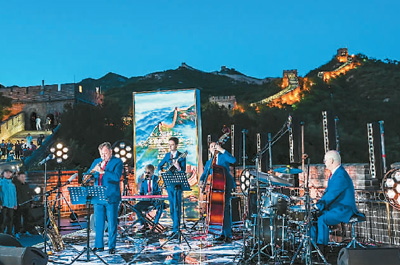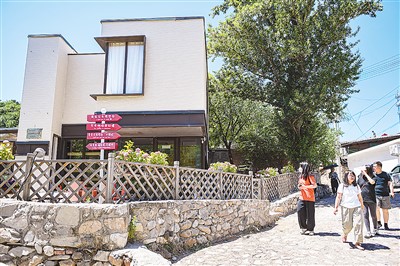China sees flourishing tourism themed on Great Wall

Photo shows the scenery of the Mutianyu section of the Great Wall in Huairou district, Beijing. (Photo/Gao Jianming)
The Great Wall, which has been in existence for over 2,000 years, is the largest and most extensive cultural heritage site in China. Over the years, under the principle of prioritizing protection and utilizing resources dynamically, the promotion of Great Wall culture has taken on new vitality, encouraging more people to learn about, protect, and love the Great Wall.
Nighttime Experiences
In July this year, the Mutianyu section of the Great Wall in Huairou district, Beijing, began to offer night tours, providing new experiences for tourists.
Visitors can ride cable cars while watching the sun set on the wall, enjoy traditional performances, and explore the mysteries of the wall under the stars through guided tours.
Recently, a woman surnamed Fang, who hails from east China’s Jiangsu Province, led her children to visit the Mutianyu section of the Great Wall.
“Night tours of the Great Wall are quite novel for us. My children especially like interactive light shows. They can see patterns of small animals projected on the watchtowers and watch projected animations showing the layout of sections of the Great Wall built in the Ming Dynasty (1368-1644),” Fang said.
Fang added that children can immerse themselves in the rich history and culture of the Great Wall while also experiencing its modern elements.
“To better meet visitors’ needs during scorching summer days, we offer night tours from 5:30 p.m. to 9:30 p.m.,” said an executive of the Mutianyu Great Wall Scenic Area. Night tours will remain until Aug. 31.
The Badaling section of the Great Wall, in Yanqing district, Beijing, is also embracing the night.

Russian saxophonist Igor Butman (1st L) and other orchestra members perform at the foot of the Badaling section of the Great Wall in Yanqing district, Beijing. (Photo/Lu Jun)
The 2024 Beijing Great Wall Concert was held there on May 17 to 18 and May 25 to 26. Celebrating the 75th anniversary of China-Russia diplomatic ties, it was attended by famous Russian orchestras, including the Moscow Jazz Orchestra.
Famous artists, including Russian saxophonist Igor Butman, presented world-class open-air musical performances to the public under the night sky, expressing the deep cultural ties between China and Russia through music.
The Beijing Great Wall Concert has been held annually since 2021 and has become a new symbol of Yanqing district’s Great Wall cultural initiative.
“At the Great Wall, audiences can get the same auditory experience with their eyes closed as they would in a concert hall, and when they open their eyes, they see this magnificent structure,” said Wang Fuying, chief director of the 2024 Beijing Great Wall Concert. Wang added that the concert is expected to be held twice a year in the future to allow the world to appreciate the charm of the Great Wall and the beauty of music.
Virtual Tours
Digital technologies are helping people learn about the Great Wall’s cultural significance. A recent livestream by Luo Zhenyu, founder of the mobile app Dedao, included a virtual tour of the Great Wall.
That day, over 800,000 netizens joined the livestream, embarking on a virtual tour of the Great Wall. Many commented on how the stream gave them a desire to visit the wall.
As the concept of protecting the Great Wall evolves and technological methods improve, the “Digital Great Wall" is helping people understand and feel the cultural significance and spiritual essence of the Great Wall alongside the physical structure itself.
A WeChat mini program allows users to tour the Xifengkou section of the Great Wall in north China’s Hebei Province on their smartphones. With modern technology, users can move freely in the virtual environment and even enjoy the beautiful scenery change of the Xifengkou section of the Great Wall between morning and dusk, as well as see how the wall would appear during different seasons and weather conditions.
To further improve digital integration with the Great Wall, the “Youth Great Wall Cultural Project” has been introduced. The project’s goal is to encourage young people and university students to become involved in the operation and design of cultural and tourism products related to or at the Great Wall, increasing the wall’s presence digitally and on new media.
Living at the wall
Shixia village is a village nestled near the Shixiaguan section of the Great Wall in Yanqing district. The area is rich in cultural heritage sites, and the historical and cultural resources found there make it a well-known “Great Wall Village”.

People visit Shixia village, a village nestled near the Shixiaguan section of the Great Wall in Yanqing district, Beijing. (Xinhua/Chen Zhonghao)
To take advantage of this status, locals have begun to develop the area’s tourism industry through operating guesthouses. In 2014, He Yuling rented 18 village courtyards and turned them into guesthouses by incorporating local food culture and intangible cultural heritage elements.
Others in the village followed and have also started operating their own guesthouses, as well as opening businesses like cafes and bookstores to complement the increase in tourists. These developments have allowed many villagers to earn an income while remaining close to their homes.
“Our village was included in the second list of national key villages for rural tourism. Visitors can feel the charm of culture revolving around the Great Wall here,” said Li Handong, Party chief of Shixia village.
As a symbol of Chinese culture, the Great Wall also attracts many global travelers.
In May, a book launch event for “Living at the Great Wall” was held at the Brickyard Retreat, a hotel located at the Great Wall, in Beigou village, Huairou district. The author, an American designer, recorded his experiences living in Beigou for many years, helping local villagers design and renovate guesthouses and hotels.
One of the most representative projects is the Brickyard Retreat, which was transformed from an abandoned roof tile factory. The original factory appearance is preserved, with kilns and chimneys converted into artistic landscapes. Visitors can not only look out at the Great Wall but also learn about the historical changes that took place at its feet.
Nowadays, “living at the Great Wall” is becoming a new trend in Great Wall tourism and culture. According to officials from Huairou district's culture and tourism bureau, to promote the inheritance of Great Wall culture and benefit the public through Great Wall tourism, the district has encouraged further integration between the wall and guesthouses by launching eight premium tourism routes related to the Great Wall. The routes have attracted over two million visitors each year and are contributing to the comprehensive revitalization of the countryside.
Photos
Related Stories
Copyright © 2024 People's Daily Online. All Rights Reserved.









